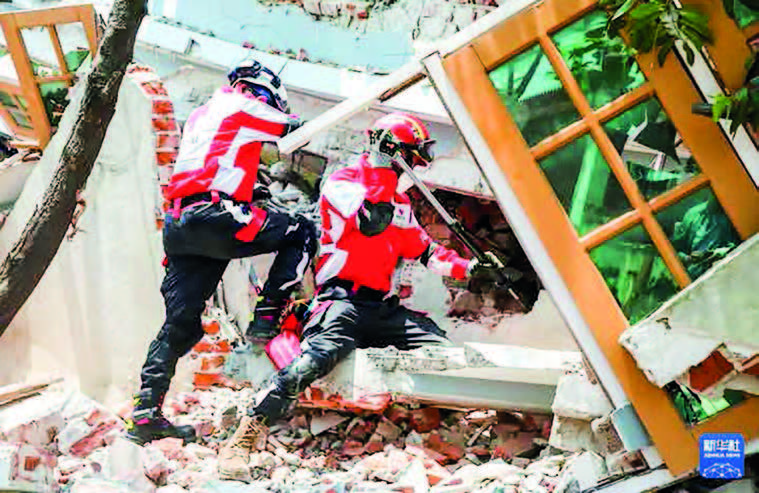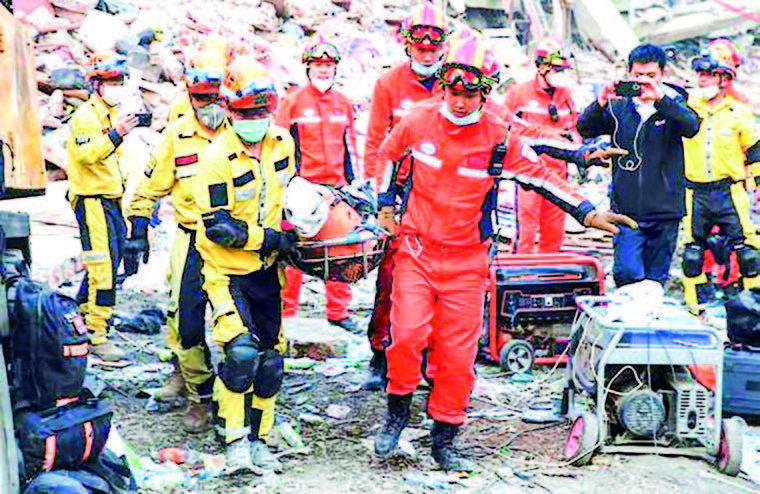By Thet Mon Tun
LOVE, sympathy, and respect have tightened among the people of China and Myanmar during the catastrophic earthquake hit in the later. China and its people, with a straightforward nature, have exposed their genuine commitment toward a shared future and shared respect with the people of the Southeast Asian country where a massively devastated quake recently struck.
A powerful earthquake hit Myanmar on 28 March 2025. The tremor occurred at a shallow depth of just 10 kilometres with its epicenter close to Mandalay, the second most populous urban area of the country. The shallow depth and proximity to major cities resulted in widespread destruction across urban centres, residential areas, religious sites, and critical infrastructure. Additionally, the quake affected many major cities from Sagaing, Mandalay, Nay Pyi Taw and southern Shan State. A total of at least 128 aftershocks have struck various parts of the country as updated on 11 April.
This apocalyptic Mandalay Earthquake has claimed 3,706 lives and left 5,027 people injured, with 130 others remained missing as of 14 April.
Unfortunately, the domestic resources of manpower, finance, and rescue techniques were not enough, and did not have capacity to save the souls. Chairman of the State Administration Council, Senior General Min Aung Hlaing, immediately declared a request to the international community to help the country in dealing with the deadly earthquake.
China is the country that arrived in Myanmar the very first among the international rescue operations. The first Chinese rescue team with 32 members with rescue equipment from Yunnan arrived in Myanmar within 17 hours after the quake. In the combination of G2G cooperation, China’s provincial authorities’ assistance, and Non-Governmental Organizations of China sending rescue teams to Myanmar, at least 150 Chinese rescuers had already arrived in the country within 24 hours after the occurrence of the disaster.
China engaged in various forms of cooperation with Myanmar authorities in facilitating the delivery of rescue personnel and relief supplies during rescuing period. These efforts included coordinated land transportation across the Muse-Ruili borderline and collaboration in the use of airspace for rapid aid deployment.
Obviously, within just five days after the disaster (by 2 April), a total of 400 Chinese rescuers were actively conducting rescue operations in Myanmar, according to a spokesperson of the Chinese Foreign Ministry Guo Jiakun. That figure reflects only the official rescue workers and does not include many other Chinese nationals in other sectors such as medical teams, logistics support, journalists for media coverage, or team members of the various Chinese non-governmental organizations.
At present, China has already sent its sixth dispatch of relief and humanitarian aid to Myanmar before Thingyan Festival (last updated on 11 April). In addition, China has decided on 10 April to provide another 1 billion Yuan (equivalent to $138 million) of emergency relief assistance to Myanmar adding to the primary 100 million Yuan assistance for rescue processes soon after the happening of the earthquake.
That is the solid bond as stated by China: “Disasters show no mercy, but humanity shows compassion and love.” China and Myanmar, bound by a shared future, have stood together in solidarity and mutual support.
Friend in need is a friend indeed: The Myanmar-China’s people-to-people ties have strengthened breaking records and reached unprecedented solidarity throughout the history of the two countries in the wake of the Mandalay Earthquake as China obviously shares weal and woe together with us, the citizens of Myanmar.
During the rescue period, it was truly heart-touching to witness tirelessly searching for and saving lives day and night by Chinese rescue workers in the hottest month of Myanmar with a temperature of +40°C in Mandalay. Moreover, earthquake-affected Myanmar people drove away mosquitoes by using the hand-fans to take care of Chinese rescuers while they took break or a rested on the platforms in the late night. That scene, despite of simple, beautifully portrays the mutual sympathy and love shared between the Chinese and Myanmar or the modest and humble behaviour of Myanmar people expressing their gratitude to the Chinese rescuers.
Thanakha is a reflection of the national identity of Myanmar. With its sun-protective and cooling properties, Myanmar people traditionally wear Thanaka for protection from sunburn.
That is why, also in the daytime, the disaster-hit local residents of Mandalay kindly put Thanaka on the arms, backs, faces, and hands of the Chinese rescuers in order to cool down the body temperature and to give a soothing effect under the weather of high temperature during their rescue operations.
China could show its compassion and fellow feeling towards Myanmar in the disaster crisis not only by the government and the rescue workers but also by its public from different walks of life – including teachers and students, medical field, technological upgrading, and donations of the businesspersons and traders.
Here are some instances: A video clip of a Chinese primary school, in which, teachers and kindergartens were praying for Myanmar, wishing to stay strong and standing shoulder together with the earthquake-hit Myanmar was vialed and circulated on social media among Myanmar netizens bear a heartfelt thanks for the shared love. Again, Chinese media stands as another pillar in sharing kindness by broadcasting the latest status which encourages the international community to pay more attention to the Myanmar earthquake, which in turn, boosts international assistance.
Reports also suggested that the technological upgrading of the DeepSeek emergency translation platform was developed within seven hours. This development of Chinese-Myanmar-English translation system of the DeepSeek was created by the National Language Service Corps of China and Beijing Language and Culture University, aiming to help better assistance in earthquake relief efforts in Myanmar. The system was intentionally designed for emergency situations, offering voice translation and map integration to improve its effectiveness in rescue operations in Myanmar. What is more, satellite systems of the Chinese space station reportedly scanned the detailed locations of damages and destructions in the earthquake to have smoother facilitating in the rescue operations.
Chinese Foreign Ministry spokesperson Lin Jian stated: “In the spirit of “Pauk-Phaw” friendship, China will continue helping the people of Myanmar overcome difficulties and rebuild their homes.”
Then, noticeably, the China International Development Cooperation Agency (CIDCA) declared on 10 April that the processes had turned disease control and rehabilitation steps in Myanmar following the rescue initiatives. According to the CIDCA, a disaster assessment and evaluation team will be sent to Myanmar in order to investigate the degree and scales of damages in the quake-impacted areas to provide action plans for disaster prevention and reduction, and to carry out healthcare services, fuel supply, and disinfection activities.
The abovementioned additional 1 billion Yuan assistance also schedules to cover restorations of cultural ancient monuments that were destroyed by the earthquake.
As a matter of fact, Chinese archeological experts have been conducting the works of maintaining and repairing the Thatbyinnyu Pahto, Bagan’s tallest temple which suffered significant damage during the 6.8 magnitude earthquake in August 2016. That heritage conservation work as well marked the 70th Anniversary of Myanmar-China diplomatic ties.
Those collaborations and assistance not only in humanitarian grounds but also in preserving the cultural relics of Myanmar echo the Chinese President Xi Jinping’s recent call for building community with shared future with neighbouring countries and China’s continuous support for shared interest among global nations.
To be honest, the kindness and unwavering support of the Chinese government and its people towards Myanmar have found a place in the deep hearts of the Myanmar people, more deeply than ever before. These moments of the highest bond of fraternal ties, marked by the Pauk-Phaw friendship between our two nations, are especially meaningful as witnessed coincidentally during the celebration of the 75th Anniversary of Myanmar-China diplomatic relations.
This article is dedicated to honouring the People’s Republic of China, the brave Chinese rescuers, and the Chinese nationals who have selflessly contributed to or participated in every rescue and resettlement operations in Myanmar. Their efforts in wiping away tears and sorrow of Myanmar’s war-torn people during times of national hardship will remain an ineradicable mark in our history and hearts.
“Earthquakes may shatter continents, but our solidarity stands unshaken”, is an expression of navigating Chinese’s shared love to Myanmar.
Thus, the mutual love, sympathy, respect, and compassions between the people of Myanmar and China have passed beyond borders and boundaries, languages and barriers, and deterrence and challenges, which prove that “true friendship shines brightest in the darkest hours.” This enduring tie will absolutely stand handing over to our next generations and descendants lasting as long as the world itself.



